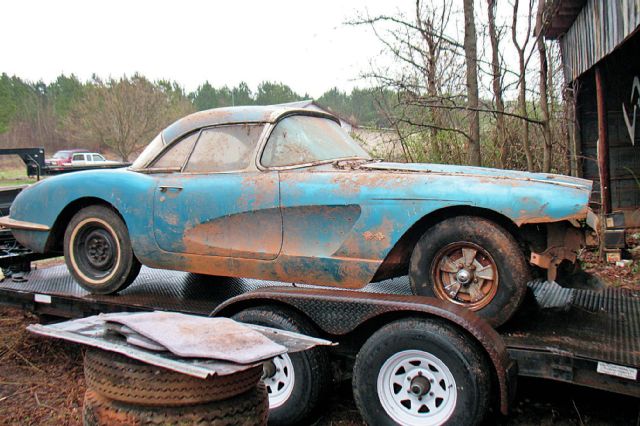
by
Michael Prince could hardly contain his excitement. He’d heard stories of his father’s ’59 fuel-injected Corvette all his life, and now he was the winning bidder for the car, walled up inside a barn for 44 years. As Prince stated, “I had to chain saw trees that were 16 inches in diameter.” Then, once inside the barn, Prince had to tear down wooden walls the owner had placed around the ’59 Vette to keep lookie-loos away from his treasure.
But, the story gets even stranger. For most of his life Michael Prince actually knew the owner, Carroll Johnson. “There was a period of time of about three years, from 2004 to 2007, when I saw him almost every work day.” The two worked for Prince’s uncle. Many times, Prince would ask if he could take a look at it or if he’d be willing to sell it.
Johnson wouldn’t say no. Instead, he would “just walk away.” Growing up, Michael heard stories from his father about the Snowcrest White, fuel-injected/four-speed Vette. Right after buying the Vette, his father “promptly removed the hubcaps and chromed the wheels and added chrome center caps to complement the wide whites.”
“He told me about running the car on Mulholland Dr. I’ve got pictures of the car with drag racing trophies sitting on the hood and the decklid.” The ’59 was a winner at the dragstrip, but wasn’t as dominant when the ’60 Corvette fuelies came out. So, Michael said his father explained how he and his brother simply went to the Chevy dealer and bought the improved ’60 model fuel-injection unit. Suddenly, he was competitive again and back on top.
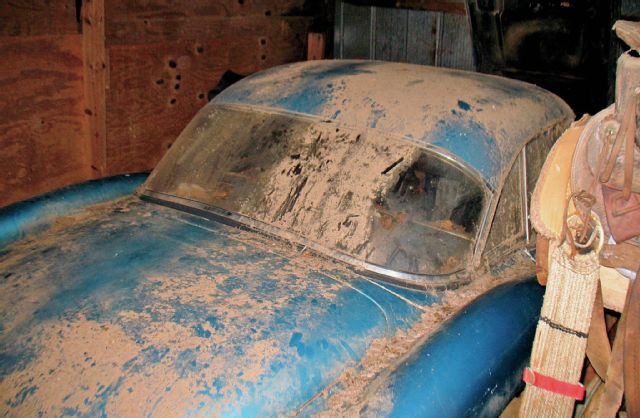
The ’59 Vette was walled up inside an inner structure inside a barn.
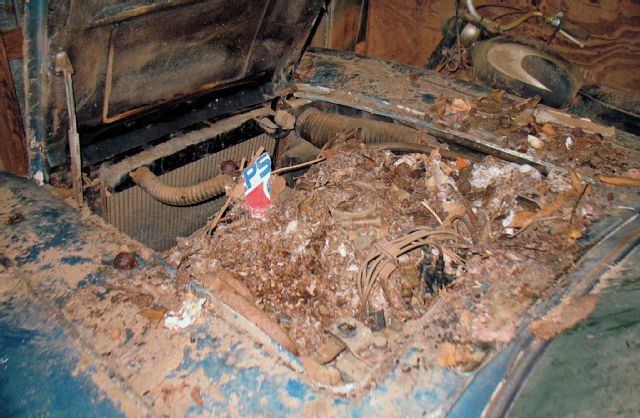
The engine was originally fuel injected, swapped out years ago for a four-barrel carburetor.
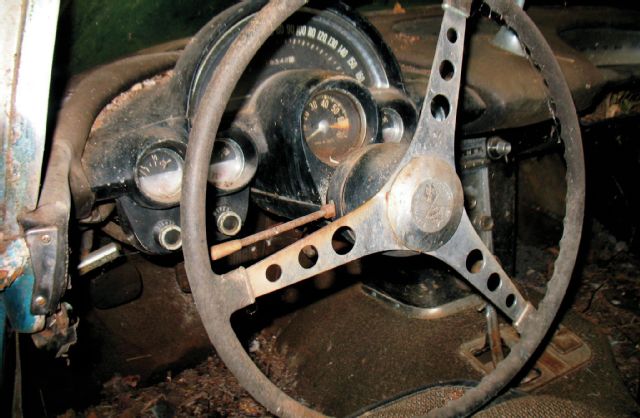
The interior was stock, but obviously tarnished by time.
The ’59 was a piece of family history from long ago and far away that intrigued Michael, who was born in 1967. His father had “a barrage of cars: a ’57 Chevy, a ’58 Chevy, a ’65 GTO. Dad was from a little town called Campobello, which is just north of Spartanburg, S.C. He moved back there, from California, in the early 1960s and took the Vette with him.”
Soon, the ’59 Vette was well known around the area. Harold kept the car pretty much stock. In 1963, Pontiac introduced the Grand Prix and Harold “had to have one.” He traded in his ’59 Vette. One of Harold’s childhood friends, Carroll Johnson, hustled down to the dealership to purchase the ’59 Vette. Johnson replaced the fuel-injection unit with a four-barrel carburetor and painted the Vette blue. He traded the chromed wheels for a set of aluminum mags.
Johnson drove the car for 5-6 years in the area and took it with him on a move to Atlanta. There, the car suffered front-end damage. When Johnson returned to Campobello in 1969, many potential buyers kept stopping by trying to buy the Vette. So, Johnson pulled the car into a barn on his parent’s farm and eventually virtually entombed the classic Vette to keep prospective buyers away.
Michael Prince told us, “Everybody knew this fellow had bought it from the dealership after my dad had traded it in, and boarded it up inside a barn. It was not unknown, but it was certainly unseen.” When his parents died, Carroll Johnson and his brother moved into the old home place on the farm. His brother died earlier and Carroll died in 2013, leaving 21 cars and all his possessions, including the Vette. He had no family and no will. His cousin liquidated the estate.
The cars and estate attracted a lot of attention. Michael Prince wanted the Vette and teamed up with his brother David and uncle to bid on a lot of 12 vehicles that included the ’59 Vette. Corvette enthusiasts in the area did not know the ’59 was a fuelie. Bidders could “take a peek” at the old Vette through a door in the barn, but they could not actually get into the space to touch the car and really check it out.
Michael’s dad died three years earlier. He had “wished to get it back,” and had asked Carroll about buying it. However, Carroll was a buyer and never a seller and Michael said Johnson “wouldn’t talk to him [his Dad] either, about the car.” It was with high anticipation that Harold’s son, Michael, cut down the trees to clear a path and then tore down the walls to reveal the Vette he’d dreamed of all his life.
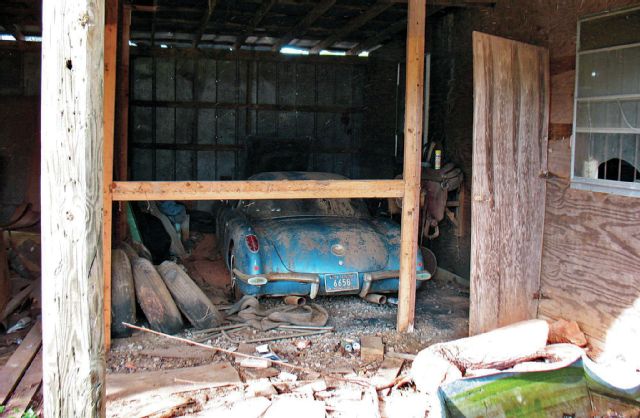
Prince took down the inner walls to reveal the Vette.
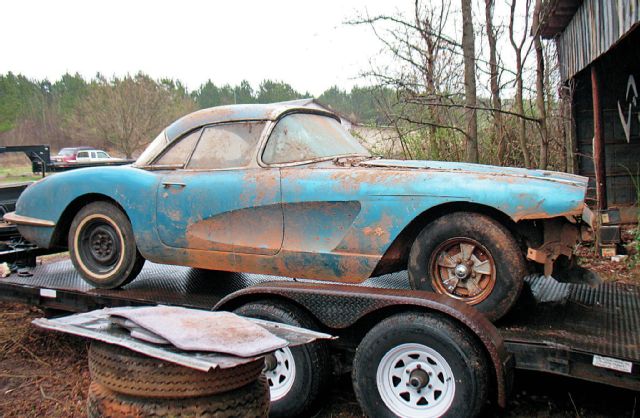
Prince could hardly believe he would finally own the ’59 his father bought new so many years ago, and which he had heard about his whole life.
“Neighbors and people who had heard about the car for all their lives came out to see. I think that they were almost as excited as I was to see that the car actually did exist.” Michael was surprised by how much the Vette had degraded, from “the years sitting in a dirt floor barn as the home to squirrels, ’coons, and field mice.” I wondered about the fuel-injection unit. Yes, Michael found the fuel-injection unit in an adjacent room in the same barn, where he also found the tach-drive distributor.
Another surprise was the original engine was not in the car. Michael and his uncle Jerry hunted through multiple barns on the 60 acres for the 283. He could not find the engine until later when his uncle talked to “this old fellow named Cooter,” who was close friends with Carroll. Cooter led them to the matching-numbers engine in another barn on the property. The ’59 has both tops, a Wonderbar radio, and came from the factory in St. Louis with the 290-horse fuel-injected 283. “I’m pretty sure it has Positraction, too,” Michael said.
He plans a complete restoration, but just got the car. One more mystery remains. As of this writing the next thing he plans to do is get the trunk open. Legend has it that Johnson rounded up N.O.S. parts to fix the front end and those components are supposedly in the trunk.
